The Béarn, first French Aircraft Carrier:
Apart the Foudre, an early seaplane carrier of 1911 converted from a 1890s torpedo-boat carrier, the wartime aircraft depot ships Campinas and Nord, France did not relied a lot on ship-based aviation during the great war, certainly not on the scale of the Royal Navy. However at the end of the war there was greater interest in the matter and from 1919 take-off tests started from the sloop Bapaume (1919), with an evaluation campaign by aviator Paul Teste and his Hanriot HD2 fighter (photo below).
*Cover: Colorized photo by Hirootoko Jr.
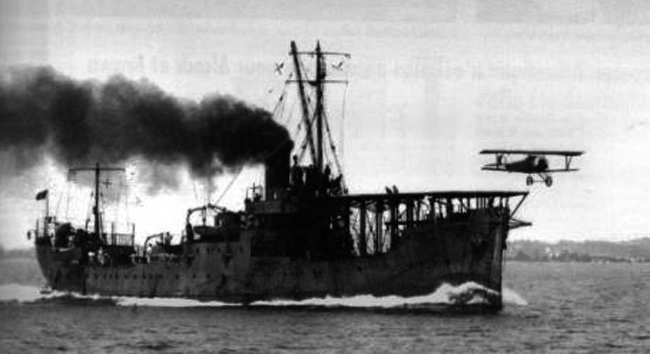
Paul Teste making trials on board the Sloop Bapaume (cc).
The Washington treaty of 1922 placed a ban on battleship construction but left a gaping hole in terms of aircraft carriers, by then still unexplored territories.
Therefore, France like UK, Japan, and the USA could choose to complete unfinished hulls of battleships or battlecruisers, after HMS Furious showed it was possible. More so, the completion of the unfinished Almirante Cochrane, as HMS Eagle from 1918, showed it was also possible on a battleship. At a time air power was still not well defined, having a ship well armored and capable to fight cruisers with a barbette armament and turrets was seductive.
Unfinished Battleships: Normandie class
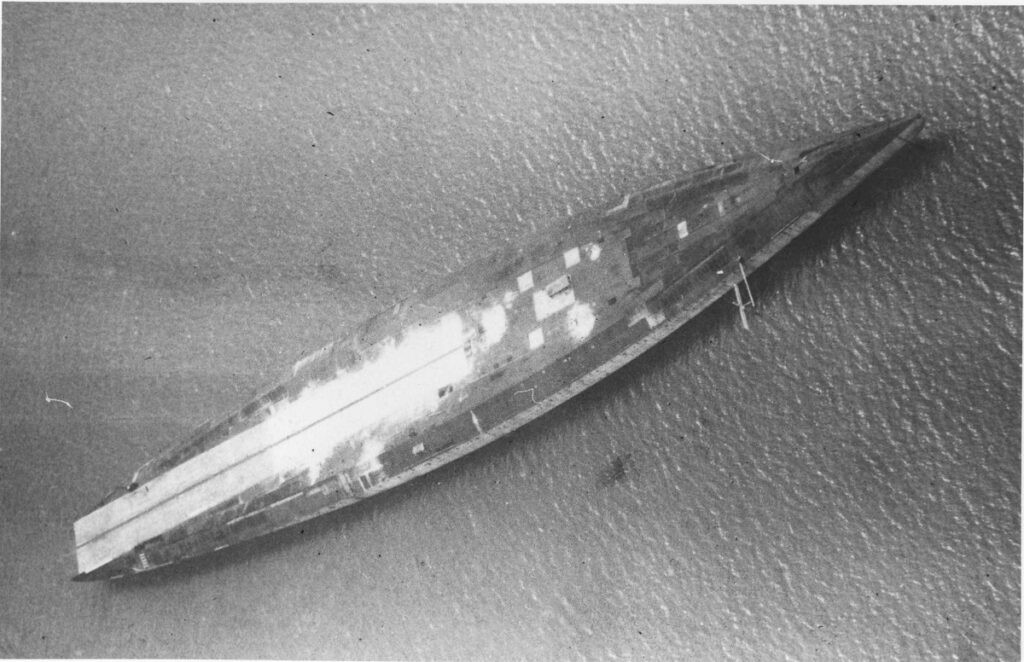
On the other hand, France had on her slipways before the war five 25,000 battleships that has been launched in 1914: Flandre, Gascoigne, Languedoc and Normandie (named after France’s historical regions) on all her four major yards, Arsenal de Brest, Lorient, FC de la Gironde (Bordeaux) and AC de la Loire.
Workers enlisted to fight and therefore the hulls were left unfinished for years. Only one ship has not been launched: Béarn, laid down in January 1914 at FC de la Méditerranée, Toulon. The reason was she was to be completed on a modified design. She was the only one with a direct drive and four Parsons turbines. All the others had neither their boilers installed, fitted on other ships, nor their guns installed, which ended on railways to pummel the front.
This famous class was the first to inaugurate the trademark French quad-turret design. The advantage was to limit the armor scheme to three turret wells and ammo rooms, therefore allowing some weight-saving for a better overall speed of 21 knots. It was good in 1913, but the same year the new British designs of “super-dreadnoughts” capable of 23 knots appeared (Queen Elisabeth class). Still, these battleships had a broadside of twelve 340 mm guns, two more than the Iron Duke class. The only backside was that a single hit can disable twice more guns. All in all, these new Normandie class would have been formidable battleships if completed. With the manpower resources of the British Empire of Germany, it could have been so, but not in the current situation.
Therefore in 1922 the new Washington treaty obliged the French to make choices, left with the same tonnage as Italy, which was felt insufficient by the naval staff to defend the French Empire, but realistic on the economic point of view. Already in service, older battleships were kept for future modernizations, while the new ones had to be broken up to respect the new tonnage limits, while recycled materials were reused in modern units.
By that time, Béarn’s incomplete hull has been launched in April 1920 to clear the slipway, and the Admiralty was not sure what to do with it. Her hull was about 8–10% complete, the engine rooms had received 25% of their equipment, boilers were 17% assembled, turrets were 20% completed, guns not received.

view of the flight deck of the Béarn after the 1935 refit, U.S. Navy Naval Aviation News May 1963
About Project 171 (1920-24)
In 1920, a French naval delegation was sent to visit HMS Argus, making observations about operations, aircraft handling, etc. They came out with the idea of a complete transformation of the unfinished ship, named Project 171. This was later ratified by the Admiralty on 18 April 1922, not long after the hull was made available for completion on a new design. Her sister-ships, the four unfinished battleships of the Normandie class would be scrapped and materials recycled into the light cruisers of the Primauguet class and further constructions.
Conversion work started in August 1923, on plans at first derived from the conversion of HMS Argus, and lasted until May 1927 after many modifications. Just after Béarn was launched, the Marine Nationale constructed a mocked-up flight deck right on the unfinished hull to perform some tests.
Indeed pilot Paul Teste multiplied landing experiments until October 1920 and advised the Marine Nationale to convert the ship for experimental purposes, to allow time to design proper scratch-built aircraft carriers (which will be the Joffre and Painlevé).
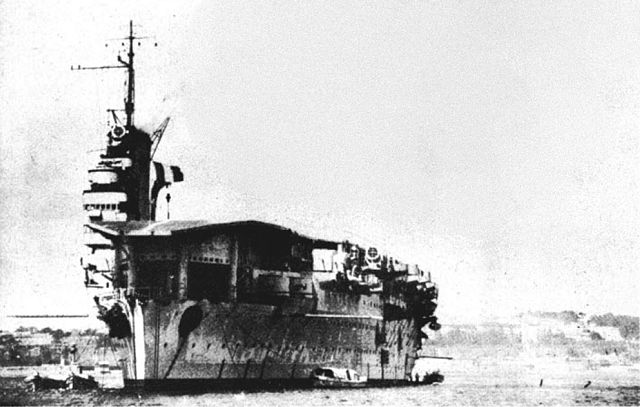
Béarn off Martinique Island 1942 (src U.S. Navy All Hands magazine January 1948)
Design of the Béarn
The Béarn was 170.6 m (560 ft) long and up to 182.6 m (599 ft) overall, useful length to build the flight deck, large enough to authorize both landings and simultaneous flight-offs.
Beam was 27.13 m (89.0 ft), enough to stack some folded wings planes on one side, and use the bulk space for spacious hangars and aviation gasoline and improved ASW protection.
Standard displacement was 22,146 long tons (22,501 t) up to 28,400 long tons (28,900 t) at the end of the conversion. The most recognizable feature at first was a retractable charthouse installed in the flight deck near the bow, something inspired by HMS Argus and the first British aircraft carriers.
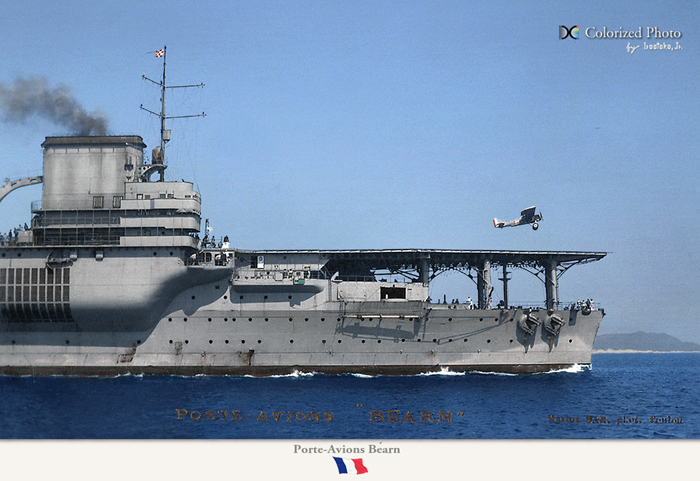
Bearn, colorized by Hirootoko Jr.
Propulsion
Béarn’s machinery consisted of two sets of steam turbines driving the inner pair of propeller shafts, plus a pair of reciprocating engines for the outer shafts. The advantage of the formula was to allow long cruises and extending the range when speed was not an issue. In case of emergency, the whole machinery could deliver up to 37,000 hp, that is 22,500 shp (16,800 kW) with the turbines alone and 15,000 ihp (11,000 kW) with the reciprocating VTE engines.
Steam was supplied by six Normand du Temple water-tube boilers. Their exhausts were truncated into a single funnel on the starboard side of the flight deck and stacked down to it was a large vented chamber to mix cooler air with the boiler exhaust. The idea was to reduce air turbulence over the flight deck.
Thanks to this system, Béarn could reach 21.5 knots (39.8 km/h; 24.7 mph) at max power, carrying 2,160 long tons (2,190 t) of fuel oil, enough for 6,000 nautical miles (11,000 km; 6,900 mi) at cruising speed of 10 kn (19 km/h; 12 mph).
Protection
As a former battleship, the hull was stripped of all and any armor, with only a symbolic 80 mm belt on the central section of the ship, with a buttress of ASW compartmentation behind. However as shown by the blueprints, there were still an angled bulkhead over the machinery, which seemed relatively thick, possibly also 80 mm. The second point is of course the flight deck, which was 25 mm thick, in relation to the usual figures for armoured ship’s less exposed vertical surface at that time.
Equipments
Béarn was built to accommodate up to 40 aircraft. The ship’s aviation facilities consisted of a 180-meter-long (590 ft) flight deck served by three electrically powered elevators: The rear and central elevators were larger, to lift the torpedo bombers and reconnaissance models which needed more taking-off space while fighter was lifted by the smaller forward elevator. To house these, there were two hangars 124-metre (407 ft) long each and below aircraft maintenance facilities and storage for spare parts.
In addition, the ship carried some 3,530 cubic feet (100 m3) of aviation gasoline and plus 15 m3 of aviation oil, with inert gas inserted in double tanks case of a rupture. There was one main lift for crashed aircraft recovery and lifting storage and payloads on board. A second one was installed during the American refit. In 1928, the provisional ropes-sandbags were replaced by hydraulic arrestor systems but no catapult was ever fitted.
Armament
Her defense, in addition to light AA guns, was ensured by the old barbette guns of the battleship. These were the eight 6.1 in (150 mm) /55 Mod 21 guns in casemates, inherited from the battleship and thought for ship-to-ship naval defense. She also had six 76 mm (3.0 in) AA guns and eight more modern 37 mm (1.5 in) AA guns. From 1935 this was reinforced by sixteen 13mm machine guns in single mounts.
This would will evolve in 1944: In addition to a radar, modern navigation systems, a new heavy-duty crane, USN equipments, she also received a brand new anti-aircraft battery of four single standard 5″/38 dual-purpose guns (to make room, barbette guns were deposed and openings removed or welded shut) and twenty-four (Six quad mounts) Bofors 40 mm guns and their fire directors, and eventually twenty-six Oerlikon 20 mm guns in individual mountings under masks, all along the bridge in bath-tub arrangements, and along the island, like American aircraft carriers.
Her level of AA protection was similar to USN Sangamon class escort aircraft carriers. She carried a wide array of planes and operated Wildcats when performing escort missions.
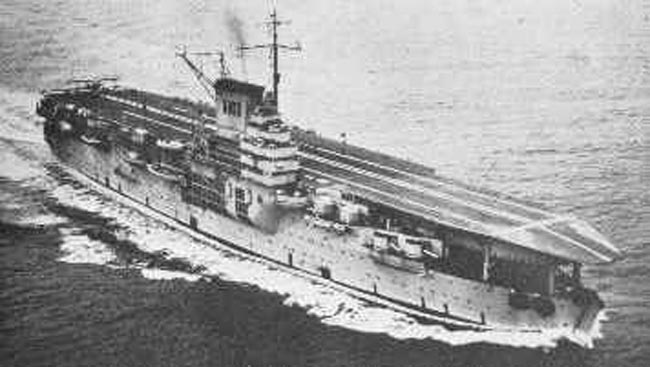
Overview of the Béarn in 1935 – src www.navweaps.com
Onboard aviation
She carried up to twelve different types of aircraft at this time of naval aviation experimentation. In 1939, her fleet consisted of Wibauld 75, LGL 32, and Levasseur PL4 torpedo bombers, all of which were out of date in 1939. Her initial group was a squadron of twelve torpedo bombers, twelve reconnaissance aircraft, and eight fighters.
Fighters
-Hanriot HD.12 (1920)
-Nieuport 21 (1920)
-Nieuport-Delage NiD-32RH (1920)
-Ansaldo/Dewoitine D.1ter
-Wibault 74 (1928)
-Loire-Gourdou-Lesseure LGL.32 (1932)
-Dewoitine D.373/D.376 (1937/39)
Bombers/Torpedo-bombers
-Levasseur PL 2 (1926)
-Levasseur PL 4 (1930)
-Levasseur PL 5 (1932)
-Levasseur PL 7 (1933)
-Levasseur PL 101 (1937)
Modernized Complement 1940:
Fighters
-Dewoitine D.790 (Navalized Dewoitine D.520)
-Latécoère 675
-Grumman F4F Wildcat (as carrier 1943-45)
Bombers/Torpedo-bombers
-Latécoère 299
-Loire-Nieuport LN.401
-Vought SB2U Vindicator (called Vought V156F): 40 delivered
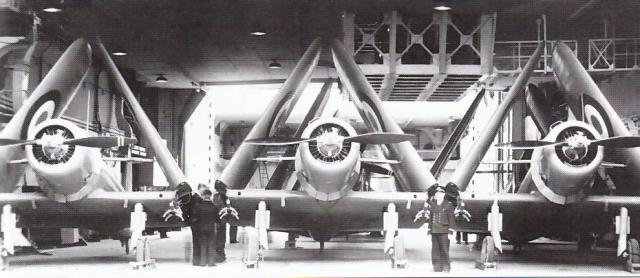
Vought 156F tested on board in 1940, here in the hangar (a French version of the Vought SB2U Vindicator). Scr forummarine.forumactif.com/t4805-france-porte-avions-bearn
The SB2U were purchased with a franchise to be later built in France, called V156F.
The Land-based naval aviation was located and tested was located in Hyères (SE France), from 1936 and was later relocated to Lanvéoc in Britanny.
Active service: The Béarn in action 1929-1967
Pioneering era (1928-35)
Béarn started active service in 1928-29, testing airplane handling, take off and landings, and training a generation of airmen. The first years were spent in the Mediterranean, with clear skies ideal for onboard aviation, and she was based in North Africa. She also toured from 15 April to 25 June 1932, stopping at Beyrouth and Athens. But she bore within herself her own limitations. She was slow, especially given the standards of the thirties, at least ten knot slower than the slowest French cruiser. In fact she was unfit for squadron exercises, and taking an active part in a combined fleet operation was out of the question.
Despite her limitations, Béarn was every bit a fully-fledged aircraft carrier, akin the Eagle. Her full deck was well cleared, with a port island, a double-stack hangar running on two-thirds of the ship, and lifts (albeit slow). Reports were not flattering on their performance, in particular one of 1937 which underlined Béarn could make land fifteen planes in one hour eight minutes, thirty-two aircraft for the Glorious in forty-two minutes and on the Saratoga forty in just eleven minutes.
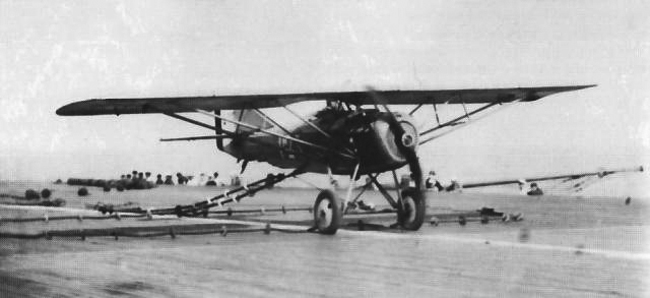
A Loire-Gourdou Lesseure LGL-32 fighter of the ET1 landing. This 1930 plane was armed by two synchronized Vickers MGs and propelled by an Hispano Suiza 8Ab of 180 hp at 240 kph. (cc)
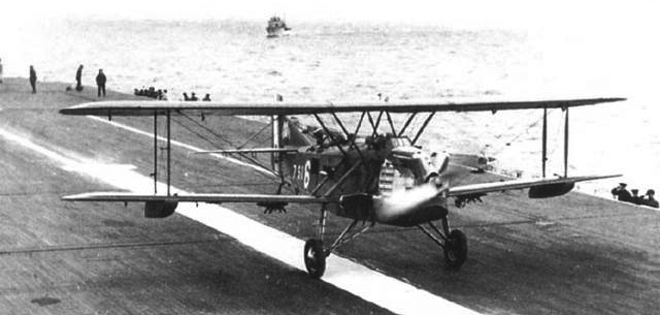
Levasseur PL101 (1933). Comparable to the Fairey swordfish, 30 of this recce/bomber were built, which served until September 1939. This 3150 kg plane, 14.20m wide and propelled by an Hispano-Suiza 12Lb 600hp (220kph), like other Levasseur planes was able to survive a sea crash thanks to its hydroplane features. (cc)
Prewar career (1935-39)
From 1936 she was redeployed in Britanny, operating from Brest. The main reason was new ships had been acquired by the fleet for the Mediterranean and Béarn was to be replaced here by the two brand new Joffre class in 1939. This would allowed the French naval air to finally accompany the squadron. Béarn replacement was planned for 1948 by an aircraft carrier of 20,000 tons (2,000 tons more than the Joffre) whose start was scheduled for 1943.
A new generation of aircraft was being developed, notably to serve onboard future ports. planes under construction, the Joffre and the Painlevé. Among these aircraft, the LN401 dive bomber, the D376/373 fighter, the naval version of the Bloch 200, and the American-built Vought V156F (SB2U Vindicator) torpedo bomber.
Wartime: 1940 campaign
All these planes never touched her flight deck. In September 1939, the Béarn Air Group fought from land bases during the May-June 1940 campaign, destroyed on the ground, thrown against columns of Panzers and eliminated by FLAK, or decimated by the Luftwaffe.
Bearn, because of her wartime limitations was sent to Martinique, neutral after carrying French gold reserves to Halifax. Until May 1940 indeed she made several rotations between Brest and Halifax before returning to the Mediterranean for training naval air pilots.
This was brief as at the end of May 1940 already she was back at Halifax to load planes ordered from the United States. US neutrality prevented indeed French ships from loading directly from any US harbor. However the process took time and when France surrendered, both Béarn had the school cruiser Jeanne d’Arc were present in Halifax, with 44 Curtiss SBC-4 Helldiver, 23 Curtiss H-75, 6 Brewster B-339 and 33 Stinson 105 on board. She sailed from Halifax on June 16, 1940 to France, but was re-routed to the West Indies on June 20, 1940 as the Germans now controlled the coast as well.
Under Vichy Control (1940-43)
The Bearn sailed to Martinique, Fort de France (French Caribean) arriving May 27 where she met the cruiser Emile Bertin. On board were loaded 290 tons of gold later stored at Fort Desaix. Planes landed, and stored in open air. Not only they quickly deteriorated, but the absence of air crews prevented any use. Despite of this, American authorities feared an for example over the Panam canal action after the British bombarded Mers-el-Kebit and interned the French fleet. Diplomatic relations of Vichy-France were broken with the British and icy with the Americans to this point.
The Bearn was kept under theoretical Vuchy control, remaining immobilized in the West Indies until July 1943. Admiral Robert, High Commissioner of France in the West Indies refused to rally to the government of Algiers despites several calls and remained faithful to the Vichy government. However later another attempt was made later with the modernization of French ships as an issue of tight negotiations between the Americans and the French Naval Mission in the United States of Vice Admiral Fennard.
Second career with the Free French
The French demanded a lot of equipment despite USN reluctance to modernize ships that were already obsolescent. Béarn will undergo a transformation into an aviation transport. She was to be escorted, partially demilitarized, sailing on a floating drydock for New Orleans on September 8, 1943. She was to be converted to the Avondale shipyard. To make room for the additional AA, the forward flight deck section and the rear one are cut off. On December 30, 1944, she left Lousiana for Norfolk where the refit was completed and on March 3, 1945, she was in New York where she carried planes in a convoy bound for Great Britain.
On March 13, 1945, she collided with an American troops transport to take (4 dead on Béarn) and had to stop on the Azores for makeshift repairs. She reached Casablanca on March 25, 1945 and was maintained for prolongated repairs until July 19, 1945.
Third career in Indochina and the Med
When fully repaired, the Béarn was used to transport the French Expeditionary Force in the Far East (CEFEO) in October 1945 and was deployed to support it until June 1946. There, she only carried planes to be based on land, not operating them, as the task was given to the modern Dixmude and Bois Belleau already.
Completely worn out when the Indochina war ended, she returned to mainland France, Toulon on July 23, 1946. On October 1, 1946 she was paid off and mothballed until December 9, 1948. She underwent a short refit to serve as floating barracks for submarine crews of the 1st ESM, compensating for the destruction of the installations of the harbor. She was finally written off the lists and broken up in 1967.
Specifications (1940) |
|
| Dimensions | 182.6 x 35.2 x 9.3 m (600 x 115 x 30 ft) |
| Displacement | 22,146 long tons (22,501 t), 28,400 long tons (28,900 t) FL |
| Crew | 856 |
| Propulsion | 2x Parsons geared steam turbines, 2x RPC steam engines |
| Speed | 21.5 kn (39.8 km/h; 24.7 mph) |
| Range | 7,000 nmi (13,000 km; 8,100 mi) at 10 kn (19 km/h; 12 mph) |
| Armament | 8 × 155 mm (6.1 in)/50, 6 × 75 mm (3 in), 8 × 37 mm, 16 × 13.2 mm AA, 4 × 550 mm (22 in) TTs |
| Protection | Main Belt: 80 mm (3.1 in), Flight Deck: 25 mm (1.0 in) |
Read More
Gardiner Conway’s all the world’s fighting Ships 1921-1947
Alexandre Sheldon-Duplaix, Histoire mondiale des porte-avions : des origines à nos jours, ETAI, Boulogne-Billancourt, 2006
Jean Moulin, L’Aéronavale française: les avions embarqués, Marines Éditions, 2006
On navypedia.org
alabordache.fr/
hazegray.org/
Bearn on wikipedia
3dhistory.de/ as build 1927
on secondeguerre.net
navalnews.com/ french navy celebrated 100 years of carrier aviation

Author’s Profile of the Béarn in 1940.
 Author’s profile of the Béarn as a carrier in 1945, after a refit in the USA. It started in April-May 1943 but only concluded in March 1945. In addition to a radar and more modern equipments, her flight deck fore and aft was curtailed and she was rearmed with four USN standard 5-in (127 mm), 24 2-in (40 mm) in 6 quadruple mounts and 26 single Oerlikon guns.
Author’s profile of the Béarn as a carrier in 1945, after a refit in the USA. It started in April-May 1943 but only concluded in March 1945. In addition to a radar and more modern equipments, her flight deck fore and aft was curtailed and she was rearmed with four USN standard 5-in (127 mm), 24 2-in (40 mm) in 6 quadruple mounts and 26 single Oerlikon guns.

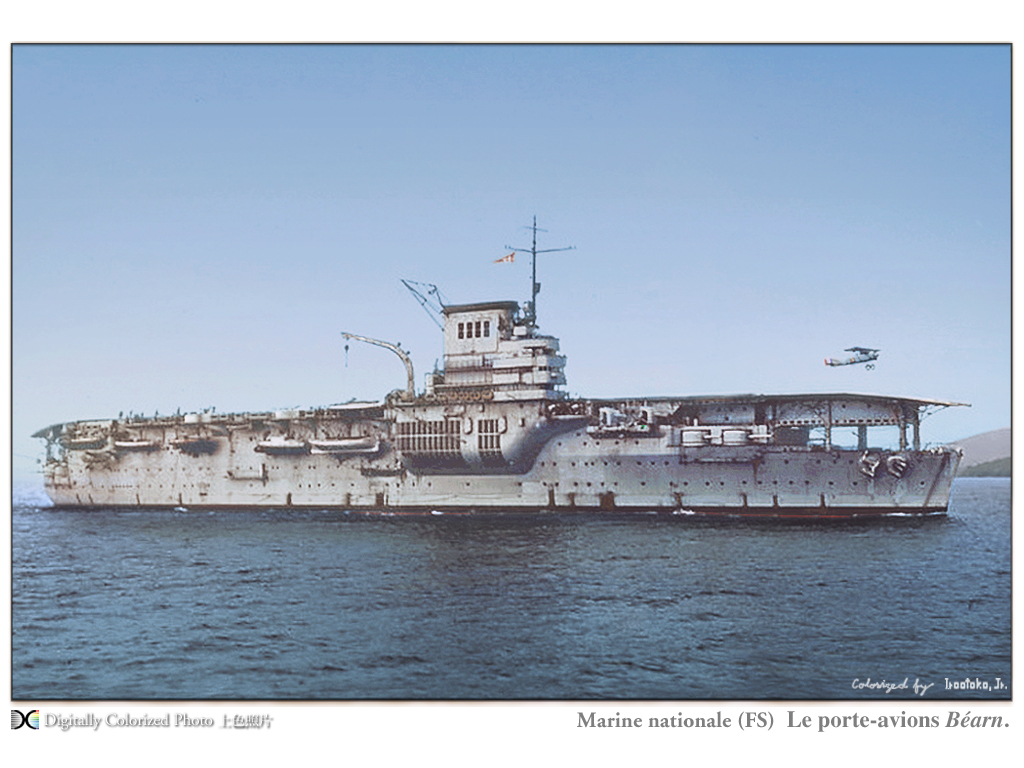

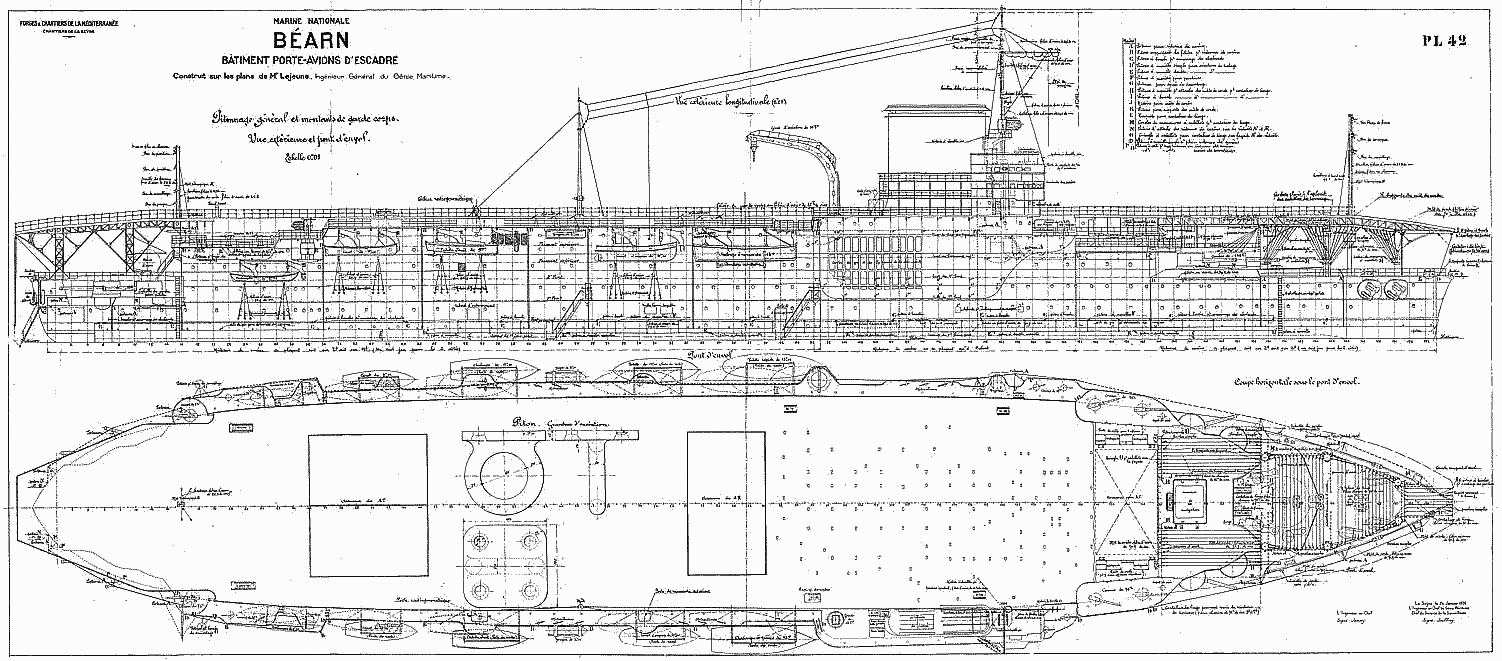
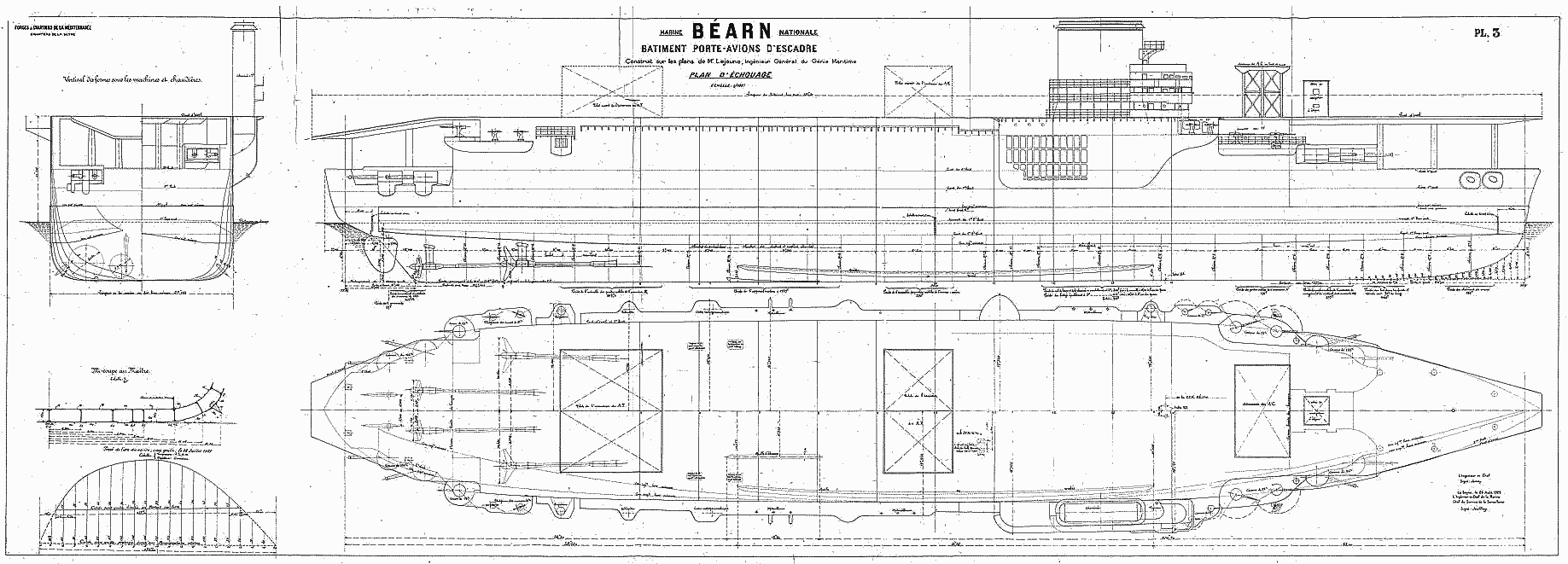
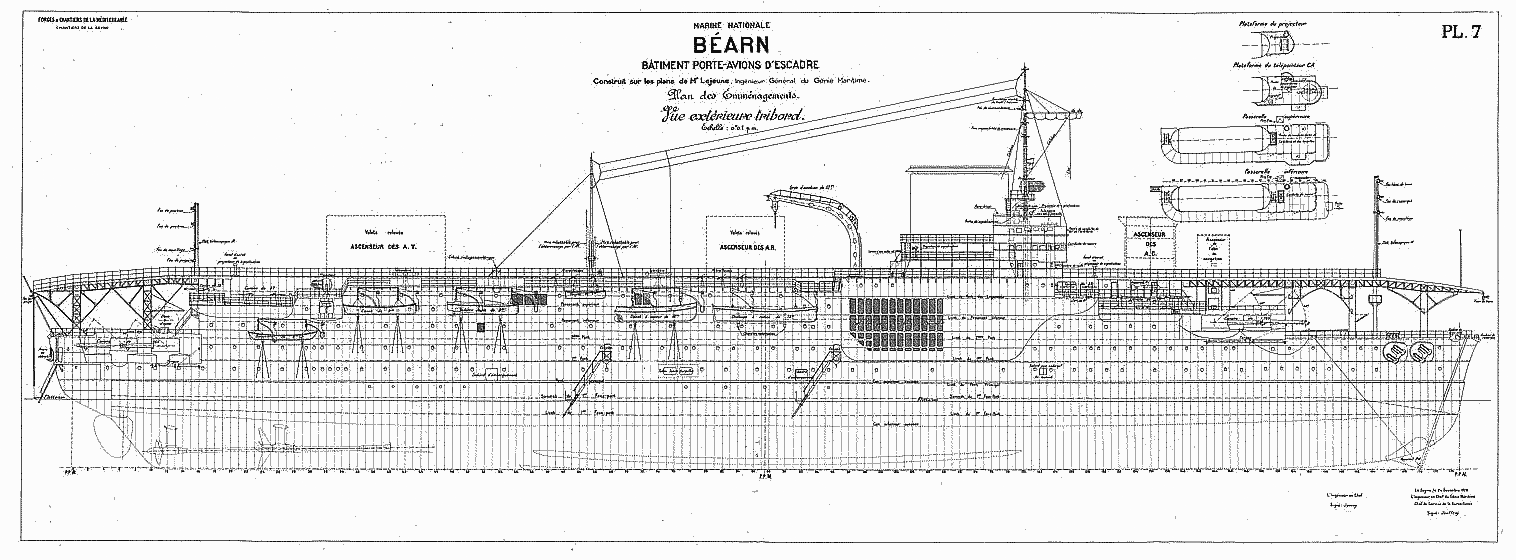

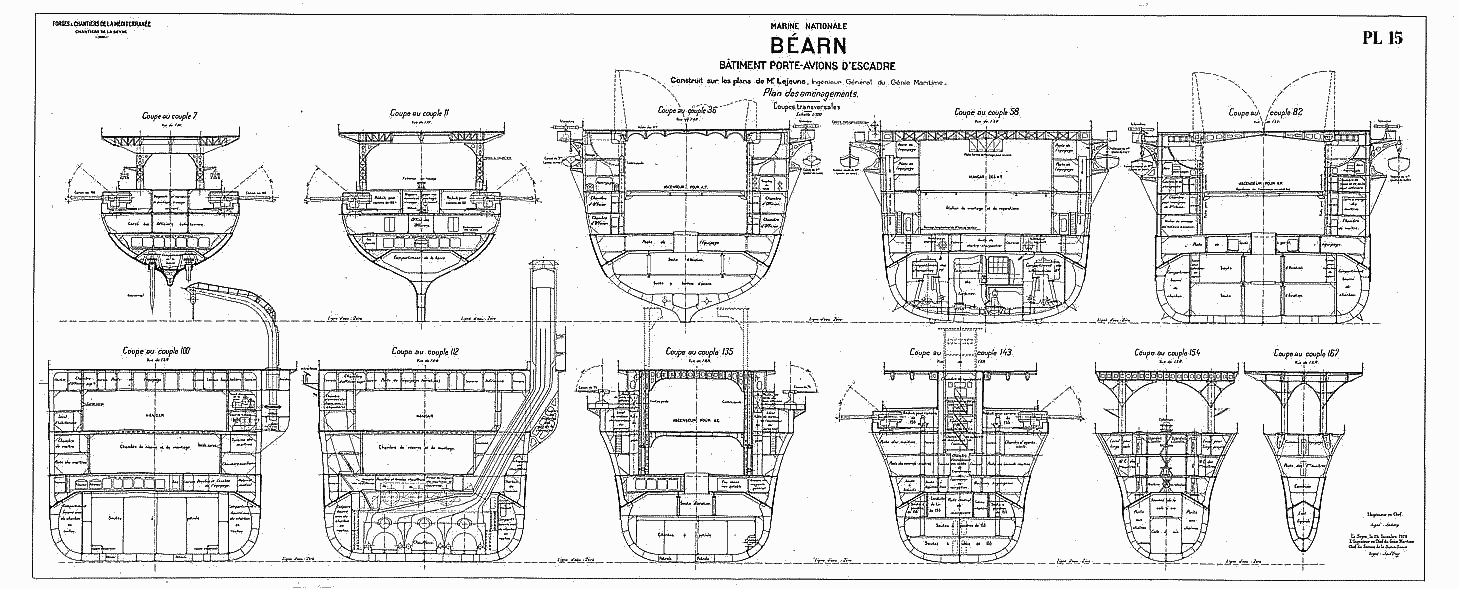
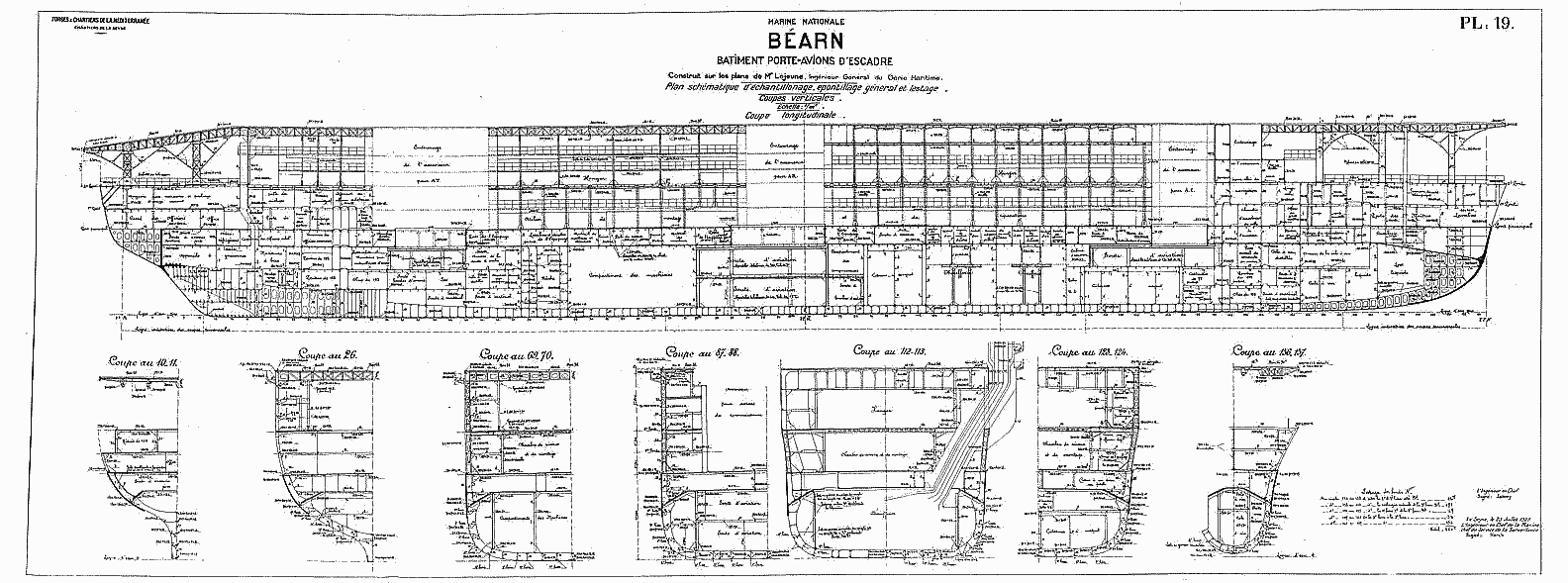
 Latest Facebook Entry -
Latest Facebook Entry -  X(Tweeter) Naval Encyclopedia's deck archive
X(Tweeter) Naval Encyclopedia's deck archive Instagram (@navalencyc)
Instagram (@navalencyc)





 French Navy
French Navy Royal Navy
Royal Navy Russian Navy
Russian Navy Armada Espanola
Armada Espanola Austrian Navy
Austrian Navy K.u.K. Kriegsmarine
K.u.K. Kriegsmarine Dansk Marine
Dansk Marine Nautiko Hellenon
Nautiko Hellenon Koninklije Marine 1870
Koninklije Marine 1870 Marinha do Brasil
Marinha do Brasil Osmanlı Donanması
Osmanlı Donanması Marina Do Peru
Marina Do Peru Marinha do Portugal
Marinha do Portugal Regia Marina 1870
Regia Marina 1870 Nihhon Kaigun 1870
Nihhon Kaigun 1870 Preußische Marine 1870
Preußische Marine 1870 Russkiy Flot 1870
Russkiy Flot 1870 Svenska marinen
Svenska marinen Søværnet
Søværnet Union Navy
Union Navy Confederate Navy
Confederate Navy Armada de Argentina
Armada de Argentina Imperial Chinese Navy
Imperial Chinese Navy Marinha do Portugal
Marinha do Portugal Mexico
Mexico Kaiserliche Marine
Kaiserliche Marine 1898 US Navy
1898 US Navy Sovietskiy Flot
Sovietskiy Flot Royal Canadian Navy
Royal Canadian Navy Royal Australian Navy
Royal Australian Navy RNZN Fleet
RNZN Fleet Chinese Navy 1937
Chinese Navy 1937 Kriegsmarine
Kriegsmarine Chilean Navy
Chilean Navy Danish Navy
Danish Navy Finnish Navy
Finnish Navy Hellenic Navy
Hellenic Navy Polish Navy
Polish Navy Romanian Navy
Romanian Navy Turkish Navy
Turkish Navy Royal Yugoslav Navy
Royal Yugoslav Navy Royal Thai Navy
Royal Thai Navy Minor Navies
Minor Navies Albania
Albania Austria
Austria Belgium
Belgium Columbia
Columbia Costa Rica
Costa Rica Cuba
Cuba Czechoslovakia
Czechoslovakia Dominican Republic
Dominican Republic Haiti
Haiti Hungary
Hungary Honduras
Honduras Estonia
Estonia Iceland
Iceland Eire
Eire Equador
Equador Iran
Iran Iraq
Iraq Latvia
Latvia Liberia
Liberia Lithuania
Lithuania Mandchukuo
Mandchukuo Morocco
Morocco Nicaragua
Nicaragua Persia
Persia San Salvador
San Salvador Sarawak
Sarawak Uruguay
Uruguay Venezuela
Venezuela Zanzibar
Zanzibar Warsaw Pact Navies
Warsaw Pact Navies Bulgaria
Bulgaria Hungary
Hungary

 Bundesmarine
Bundesmarine Dutch Navy
Dutch Navy Hellenic Navy
Hellenic Navy Marina Militare
Marina Militare Yugoslav Navy
Yugoslav Navy Chinese Navy
Chinese Navy Indian Navy
Indian Navy Indonesian Navy
Indonesian Navy JMSDF
JMSDF North Korean Navy
North Korean Navy Pakistani Navy
Pakistani Navy Philippines Navy
Philippines Navy ROKN
ROKN Rep. of Singapore Navy
Rep. of Singapore Navy Taiwanese Navy
Taiwanese Navy IDF Navy
IDF Navy Saudi Navy
Saudi Navy Royal New Zealand Navy
Royal New Zealand Navy Egyptian Navy
Egyptian Navy South African Navy
South African Navy






























 Ukrainian Navy
Ukrainian Navy dbodesign
dbodesign
One of the more unusual aircraft carriers to see service during WW2.